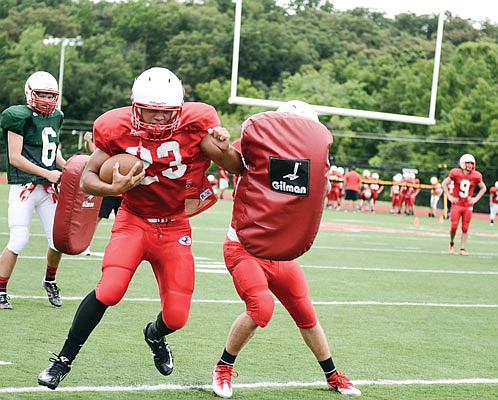There could be quite a few safety hurdles to clear for high school sports to return this fall in Missouri.
The National Federation of High Schools released a set of guidelines for its members, including the Missouri State High School Activities Association, to follow for the resumption of sports later this year. The guidelines, given to state associations Monday and released to the public Tuesday, are from the NFHS Sports Medicine Advisory Committee as how state associations can consider approaching the varied issues of resuming high school athletics and activities.
"We are greatly indebted to the NFHS Sports Medicine Advisory Committee for its work in formulating this guidance for re-opening high school athletics and activities," said Dr. Karissa Niehoff, NFHS executive director. "It is important to be clear that this is guidance for individual states to consider as they return to activities this fall.
"States will utilize the guidance in this document as it best fits their state after consulting with local and state health departments."
The guidelines are based on a document released by the White House last month in regard to opening the country by three phases.
The NFHS recommends state associations consider some questions to start the process, including:
Will the state association conduct a regular season or championship if public schools are closed and using remote teaching?
Will the state association conduct a regular season or championship if schools are closed only in COVID-19 "hotspots"?
Will the state association conduct a regular season in sports deemed "lower risk" for COVID-19 transmission, while canceling those considered "higher risk"?
The "higher risk" sports and activities include football, wrestling, competitive cheer and dance.
They are deemed higher risk because they involve close, sustained contact between participants, lack of significant protective barriers and a high probability respiratory particles will be transmitted between participants.
Some sports are deemed "moderate risk." Among those offered in Mid-Missouri include basketball, volleyball, baseball, softball, soccer, tennis, some individual field events in track, and 7-on-7 football.
They are deemed moderate risk because they involve close, sustained contact, but have protective equipment in place that may reduce the opportunity of respiratory particle transmission.
Volleyball, baseball and tennis can be lower risk with appropriate cleaning of equipment and the use of masks by participants.
The "lower risk" sports are those that can be done with social distancing or individually with no sharing of equipment or the ability to clean equipment between use by competitors.
Those include individual running and throwing events in track and field as well as cross country, with the use of staggered starts.
III
In Phase 1 of the return, which is the current one, all coaches and students should be screened for signs or symptoms of COVID-19 prior to a workout. That includes a temperature check. That information from the screening should be recorded and stored for a record of everyone present in case someone develops COVID-19.
There should be no gathering, inside or outside, of more than 10 people using pods, meaning the same group always working together with a minimum of 6 feet between each individual at all times. Locker rooms should not be used and there should be no shared equipment without cleaning after each use.
Examples of practice limits include:
A basketball player can shoot with a ball, but a team should not practice with or pass a single ball among multiple players.
A football player should not participate in team drills with a ball that will be handed off or passed to other teammates. Contact is not allowed and there should be no sharing of tackling dummies or blocking sleds.
A volleyball player should not use a ball that others touch or hit in any manner.
Baseball and softball players may hit in cages, throw batting practice without a catcher. Baseball and softballs must be individually collected and cleaned.
Wrestlers may drill without touching a teammate.
All athletes should bring their own water bottle and hydration stations should not be used.
III
In Phase 2 recommendations, the physical screenings should continue.
No gatherings of more than 10 people at a time inside should be allowed, but up to 50 individuals may gather outdoors for a workout. Appropriate social distancing should be used.
Practices and competitions may resume in lower risk sports, with participants using their own water bottle. Hydration stations should not be used.
III
In Phase 3, gatherings of up to 50 individuals will be allowed indoors or outdoors with the proper social distancing. Physical screenings should continue.
Moderate risk sports practices and competitions could resume, with modified practices to begin for the higher risk sports. Pre-practice screenings should continued to be used. Hydration stations may be used, but must be cleaned after every practice/contest.
III
When games resume, it is recommended a three-tier approach be used to decide who could be there.
Tier 1 are essential - athletes, coaches, officials, event staff, medical staff and security. Tier 2 are preferred - media. Tier 3 are non-essential - spectators and vendors.
Only Tier 1 and 2 personnel will be allowed to attend events until state/local health departments lift restrictions on mass gatherings.
The NFHS Sports Medicine Advisory Committee has 15 members. The committee is composed of medical doctors, certified athletic trainers, high school coaches and officials, research specialists snd state high school association executives.
It is intended as ideas for state associations to consider with their respective sports medicine committees and state health departments in designing return plans that will be in accordance with state or local restrictions.
"We believe this guidance document will be a tremendous resource for our member state associations as they determine the timetables for re-opening sports and activities," Niehoff said. "The NFHS Sports Medicine Advisory Committee utilized recommendations from the Centers for Disease Control and Prevention (CDC), as well as some return-to-play considerations by the United States Olympic & Paralympic Committee (USOPC), in formulating this guidance document for re-opening athletics and other activities in our nation's schools."

